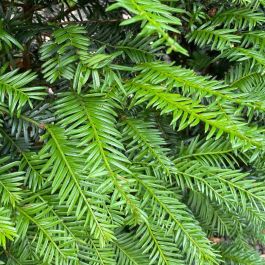Taxus baccata Hedge Plant Description
Taxus baccata or English Yew is a classic British conifer hedge plant. Yew creates an attractive, native screen that looks striking when trimmed into formal shapes or organic curves. The dark foliage of a Taxus baccata plant is scattered with fleshy red fruits in the autumn, which prove popular with a variety of wildlife. Yew plants work equally as well planted for aesthetic purposes in a garden, or used for landscape hedging, due to the traditional appearance and tough nature of these hedge plants.
Popular Uses for Taxus baccata
If you’re looking to create a perfectly neat, formal hedging, as well as sweeping curves and unusual shapes, for example, cloud pruning, Yew is ideal and will enable you to achieve your perfect landscape design. Yew is also perfect if you’re sunlight is limited as this hedge plant is great for shaded sites and a fantastic option when faced with awkward positions. Taxus baccata is tolerant of any soil type except for extremely wet conditions. Not only does Yew hedging make an effective privacy screen, but it also acts as a barrier for noise and wind, so ideal for urban areas. Aside from its extraordinary features, English Yew provides a striking, dark-green backdrop for colourful plants and shrubs in the garden.
Combine Yew Hedge Plants With
Yew hedging looks brilliant when planted alone; however, plants such as Viburnum or Rose can provide a colourful, visual texture when interplanted with Yew, and can soften the sometimes harsh shape.
Growth rate of English Yew (Taxus baccata)
Taxus baccata hedging is renowned for being slow growing; however, it does maintain an average growth rate of 20-40cm a year, reaching a good height at 2m-4m.
Care and Pruning Advice for Yew (Taxus baccata) Hedging
English Yew hedge plants require plenty of water in the first few years while establishing; however, they cannot tolerate wet feet. Yew hedging is low maintenance with no regular pruning necessary, although it does take well to trimming when required. Please take a look at our Hedging Care Advice page for further information.
Common Yew Hedge Problems
All the hedging and plants we supply at best4hedging are fresh and healthy, and well looked after our nurseries. However, being a living specimen means that sometimes problems can occur. Here is a list of common issues that can affect Yew:
Phytophthora – A large genus of microscopic pathogens, often described as a fungus, and although they resemble fungi, they are distinctly separate. A disease associated with heavy and waterlogged soils, Phytophthora will attack and kill the roots of Taxus.
Symptoms – Above ground, the foliage will turn a dark matt green or brown. These are symptoms indicative of poor water uptake, as the roots are progressively destroyed, and could be mistaken for drought or honey fungus. Below ground, smaller roots will have rotted away and more extensive roots will appear blackened and will be soft and easily broken. As this is a microscopic pathogen, there will be no visible signs of its presence.
Natural Control – Improve soil drainage with grit or land drains. Remove and destroy all infected plants and replace topsoil in the immediate vicinity if practical to do so – plant with less susceptible species (see Appendix II). There is no effective chemical control for Phytophthora in the soil.
Vine Weevil (larvae) (Otiorhynchus sulcatus) - Vine weevil is a beetle that attacks a wide range of plants, but it is the larvae that causes the most damage over autumn and winter when they feed on the plant roots.
Symptoms –The larvae are around 5-10 mm long, creamy white colour with tan-brown heads, they live in the soil and eat the fleshy young roots in autumn and winter. This can result in wilting and death of the plant.
Natural Control – To control the larvae use the microscopic nematode Steinernema kraussei which is available from garden centres. This tiny creature invades the body of the grub and kills it. For best results, water into the soil in August or September when the soil temperature is still warm enough for the nematode to be effective (5-20ºC) and before the vine weevil grubs have grown large enough to cause severe damage.
Chemical Control – There are no chemical control methods available for application to the soil around plants, though a product containing acetamiprid is available for pot grown plants.
Recommended Planting Density for Yew (Taxus baccata)
For specific information on the planting density of Yew hedging, please see the product table. In the 'No. Per Metre' column, you will find our recommended plant density for individual plant species and root type. You can find out more information about calculating planting density here.
Yew hedge plants are sold as; root ball hedging which is available to plant between autumn (usually October) and spring; bare roots which can be planted from November through to late April/early May (depending on the season) and pot grown or cell grown plants, which are available to buy year-round.
Most of our Taxus baccata plants are grown in Britain by hedging professionals with vast amounts of horticultural know-how. Although, now and again, it is necessary to source Yew from specialist nurseries abroad, where we make sure that the quality is of the very highest standards. At best4hedging, we continuously strive to deliver the freshest plants of the utmost quality while maintaining competitive prices, to ensure you can buy Yew hedge plants with confidence from our nursery in Lancashire.




































